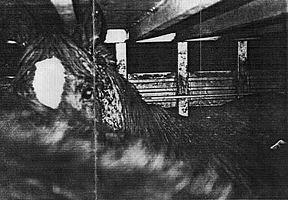
Legislation Information
Pending Legislation
PA's Electronic Bill Room
Type in the word "equine" in the search box to locate bills, (proposed legislation) relating to horses.
Federal Laws
Proposed regs will legalize every inhumane practice identified in the transport of horses to slaughter!

Doubles will be legal for 5 years AFTER the proposed regs go into effect. It has already been 4 1/2 years, that makes for 10 years of the continued use of doubles after this legislation passed..
EPN's Comments
on Proposed Regulations For the 1996 Commercial Transportation of Horses To Slaughter Act
CA Equine Council's
Comments on the Proposed Regulations For the 1996 Commercial Transportation of Horses To Slaughter Act
State Laws
Proposition 6,
The PROHIBITION of Horse Slaughter and Sale of Horsemeat for Human Consumption Act Of 1998, Does Not Violate The Commerce Clause
Horsemeat Laws
1996 Commercial Transportation Of Horses To Slaughter Act
December 7, 2001
Final Rule Commercial Transportation of Horses to Slaughter Act
American Horse Council, American Horse Protection Association, & Humane Society of US
propose to legalize every inhumane practice identified in the transport of horses to slaughter & put the very people identified as the abusers, the "killer buyers" in charge of the horses!
Proposed Regulations For the 1996 Commercial Transportation of Horses To Slaughter Act
USDA Animal & Plant Health Inspection Service, APHIS
Approval of Livestock Facilities;
Interstate Movement of EIA Reactors
USDA Food Safety Inspection Service, FSIS, Regulations
Biological Residues in Horses;
Slaughter of Foaling Mares;
Slaughter of Sick Horses;
USDA APHIS Humane Slaughter Act

AZ Transport Law
CA Transport Law
CT Transport Law
MA Transport Law
MN Transport Law
NY Transport Law
Ag and Markets, Section 359-a

Horses inside double deck cattle trailer stopped by the NYSP. The owner was later convicted & fined $3000.00.
VA Transport Law
Vermont Transport Law
PA Anti Cruelty Law
Title 18, Section 5511
Sign Posted at PA Horse Auctions is NOT the Law!
Sign outside auctions is incorrect!

Sign posted outside 2 PA horse auctions regarding the PA Anti Cruelty Statute is incorrect! " Maybe the posting of this sign has something to do with "the agreement" that the auctions and the PA SPCA have with each other...
U.S. Anti-Cruelty Statutes
PA Domestic Animal Act
Licensing of Dealers & Haulers
EIA Regulations, Coggins Test
PA Dead Animal Act
Requirements for Removal of Dead Animals
PA Animal Markets
General Provisions
Records
Transactions From Trucks
IL Horsemeat Act
Texas Law
Sale of Horsemeat for Human Consumption
Prohibits Sale of Horsemeat For Human Consumption
Texas Attorney General Cornyn States TX Law
Prohibiting Sale of Horsemeat Applies to the 2 Texas Horse Slaughterhouses!
Links
California Voters "Just Say Neigh" to Horse Slaughter!
HoofPAC
Shop online at IGive.com with over 400 great stores you know & love- including Back In the Saddle! Up to 26% of the purchase price is donated to the EPN!
The EPN gets $5 extra the first time you shop!
PayPal accepts credit cards! Please send your tax deductible donation to the:Equine Protection Network, Inc.,
P. O. Box 232, Friedensburg, PA, 17933.
Shop for CD's at CDRush.com & the EPN Benefits!
Put "EPN" in the Coupon Code box when you place your order.
Now you can save money on your favorite music and help the horses at the same time!
HoofPAC is the political action committee that has been formed to end the slaughter of America's horses. Cathleen Doyle, founder of HoofPAC, led the successful Save The Horses campaign in 1998 that made the slaughter of California's horses a felony.

Commercial Transportation of Horses to Slaughter Act of 1996
Source: Library of Congress Federal Agriculture Improvement and Reform Act of 1996
Title IX: Miscellaneous
Note- The words," SAFE" and/or "HUMANE" do NOT exist in this law.
Articles in horse magazines refer to this legislation as
"insuring the safe and humane transport
of horses to slaughter."
Repeat, the words, "SAFE"
and/or "HUMANE" do NOT exist in this law.
Read the law, then read New York State Law.
Where in this law does it state it is for the safe & humane
transport of horses? Their welfare?
TITLE IX--MISCELLANEOUS
SUBTITLE A--COMMERCIAL TRANSPORTATION OF EQUINE FOR SLAUGHTER
SEC. 901. FINDINGS.
Because of the unique and special needs of equine being
transported to slaughter, Congress finds that it is appropriate
for the Secretary of Agriculture to issue guidelines for the
regulation of the commercial transportation of equine for slaughter
by persons regularly engaged in that activity within the United
States.
In this subtitle: (1) COMMERCIAL TRANSPORTATION- The term `commercial transportation'
means the regular operation for profit of a transport business
that uses trucks, tractors, trailers, or semitrailers, or any
combination (2) EQUINE FOR SLAUGHTER- The term `equine for slaughter'
means any member of the Equidae family being transferred to a
slaughter facility, including an assembly point, feedlot, or
stockyard . (3) PERSON- The term `person'-- (A) means any individual, partnership, corporation, or
cooperative association that regularly engages in the commercial
transportation of equine for slaughter; but "subject to the availability
of appropriations"- This means Congress has to approve money
each year in the budget. Recently $400,000 was approved to undertake
studies & draft guidelines. $400,000 is a miniscule amount.
Ask your Congressman. The studies included water deprivation
studies on horses. Your tax dollars paid for horses
to suffer.
(b) ISSUES FOR REVIEW- In carrying out this section, the
Secretary of Agriculture shall review the food, water, and rest
provided to equine for slaughter in transit, the segregation
of stallions from other equine during (2) conduct such investigations and inspections as the
Secretary considers necessary; and (3) establish and enforce appropriate and effective civil
penalties.
Nothing in this subtitle authorizes the Secretary of Agriculture
to regulate the routine or regular transportation, to slaughter
or elsewhere, of-- (1) livestock other than equine; or (2) poultry. This subtitle shall become effective on the first day of
the first month that begins 30 days or more after the date of
enactment of this Act.
Passed in 1996, still nothing has changed for the horses,
contrary to what you read in horse magazines. New York State
is not waiting, their law was put on the books in 1981. Read the EPN's
and CA
Equine Council's comments on the Proposed
Regulations that will legalize every inhumane practice identified
in the transport of horses to slaughter, and put the very people
identified as the abusers in charge of the horses' welfare! This law will do nothing to insure the safe and humane
transport of horses to slaughter. Compare this law, to New
York State's Law.
Note-
How do you enforce a "guideline" A guideline is not
a regulation, it is not a law.
SEC.
902. DEFINITIONS.
thereof, propelled or drawn by mechanical power on any highway
or public road.(B) does not include any individual or other entity referred
to in subparagraph (A) that occasionally transports equine for
slaughter incidental to the principal activity of the individual
or other entity in production
agriculture.
SEC. 903. REGULATION OF COMMERCIAL TRANSPORTATION OF EQUINE FOR
SLAUGHTER.
(a) IN GENERAL- Subject to the availability of appropriations,
the Secretary of Agriculture may issue guidelines for the regulation
of the commercial transportation of equine for slaughter by persons
regularly engaged
in that activity within the United States.
transit, and such other issues as the Secretary considers appropriate.
(c) ADDITIONAL AUTHORITY- In carrying out this section, the Secretary
of Agriculture may--
Note
the word, "may" instead of "shall"
(1)
require any person to maintain such records and reports as the
Secretary considers necessary;
Note- civil penalties- No Police Enforcement. USDA does not enforce
their regulations at auctions now, how are they going to enforce
this?
What about the Canadian slaughterhouses? The USDA has no authority
in Canada. Is the slaughterhouse going to turn a load of horses
away, if the load is in violation?(of whatever guidelines are
drafted) States & Canada will not allow horses into the state
or country if they are in violation.
What is appropriate? What is considered necessary?
SEC. 904. LIMITATION OF AUTHORITY TO EQUINE FOR SLAUGHTER.
SEC. 905. EFFECTIVE DATE.
Points to Ponder
Save America's Horses! |
|||||||
|
Please send your tax deductible donation to: Equine Protection Network, Inc., P. O. Box 232, Friedensburg, PA, 17933 |
||
Save America's Horses- Make the Commitment to Your Horse! |
||
|
Photos On This Page CANNOT be Used Without Written Permission
|
||


